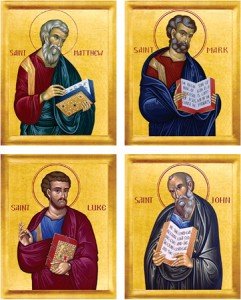 There is another theory I would like to share with my readers about the Synoptic Problem (I won’t define this at this point since I’m sure that, if you have been reading this article, you will understand of what I write). This theory actually bears the name of a particular author, L. Vaganay. He promoted the idea that the oral tradition that served as the foundation of the written narratives were found in two different sources that were put into writing as small collections of words and/or incidents. In Gospel form these became Aram M, not identical with canonical Matthew. Another early collection consisting of saying and discourses, he names “S”. It was also written down in Aram and it, together with another oral tradition, were translated into Greek. The earliest canonical Gospel, Mark, used as its sources “Mg” (the Greek translation of Aram M) and the oral tradition of Peter’s preaching, but not “S”. Canonical Matthew used as sources Mark, “Mg”, and “Sg” which was the Greek translation of “S” plus elements of Peter’s preaching. Vaganay also speculates that Luke used as sources Mark, “Mg”, “Sg” and elements of oral tradition. Vaganay introduced “S” into the solution of the problem because he felt that Aram M translated into Greek was insufficient to explain all the Synoptic tradition. He claims that this source has nothing in common with “Q”.
There is another theory I would like to share with my readers about the Synoptic Problem (I won’t define this at this point since I’m sure that, if you have been reading this article, you will understand of what I write). This theory actually bears the name of a particular author, L. Vaganay. He promoted the idea that the oral tradition that served as the foundation of the written narratives were found in two different sources that were put into writing as small collections of words and/or incidents. In Gospel form these became Aram M, not identical with canonical Matthew. Another early collection consisting of saying and discourses, he names “S”. It was also written down in Aram and it, together with another oral tradition, were translated into Greek. The earliest canonical Gospel, Mark, used as its sources “Mg” (the Greek translation of Aram M) and the oral tradition of Peter’s preaching, but not “S”. Canonical Matthew used as sources Mark, “Mg”, and “Sg” which was the Greek translation of “S” plus elements of Peter’s preaching. Vaganay also speculates that Luke used as sources Mark, “Mg”, “Sg” and elements of oral tradition. Vaganay introduced “S” into the solution of the problem because he felt that Aram M translated into Greek was insufficient to explain all the Synoptic tradition. He claims that this source has nothing in common with “Q”.
The criticisms leveled at Vaganay’s theory have stressed that his system is very complex. In his desire to reject the Two-Document Hypothesis he has reconstructed a similar theory substituting “S” for “Q”. There are about 60 passages that scholars commonly allocate to “Q”; over 40 of them are in “S” – therefore, is there an actual distinction between “S” and “Q”? He presents us with no good reason why Mark should have been written.
There is one last theory I would like to share with my readers. It is called the Multiple Documentation as the Basis for the Whole Gospel Complex. This theory consists mainly in supposing that a rather mixed combination of documents serve as the origins of the Synoptic Gospels. It is considered by some as a middle course because it does not insist on the simplistic approach of the Oral-Tradition Theory nor on the rigid approach of the theory of literary interrelationships. In its original form, the words and deeds of Jesus were not supposed to have been collected in one book but, rather, contained in diverse documents that circulated among the various Christian Communities. (More to follow)
